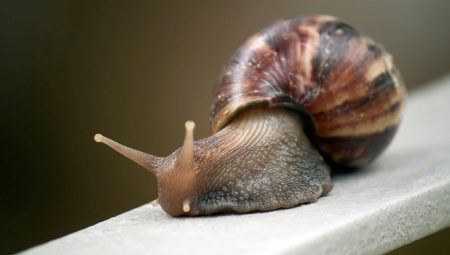Care and maintenance of snails at home for an uninitiated person looks quite simple and understandable. But in practice, worries with such a pet are no less than with other representatives of wildlife. How can beginners properly keep small and large snails at home? What is the difference between land and water species of beautiful decorative mollusks? What temperature, humidity, feeding regimen should be observed?
In search of answers to all these questions, novice breeders often choose a trial and error method and are disappointed in their new pets. You can avoid these consequences if you study in advance all the subtleties of the content of snails of different species. An experienced owner, without any unnecessary difficulties, maintains the health of pets and the environment in the place of their residence in optimal condition, and for this it takes real pleasure from communicating with domestic mollusks.

Selection and arrangement of the aquarium
When creating a home for domestic snails, it is worth considering the features of their natural habitat. Land animals require a molluskarium or terrarium with a volume of 10 liters per 1 individual. For large exotic species, it is recommended to choose a capacity of 15-20 liters per snail.
Aquatic species need a classic aquarium with plants or can be planted in a ready-made tank. For 1-2 individuals, a volume of 5 liters or more is needed.Snails are not very sensitive to the acidity and hardness of water, but they react negatively to the high content of phosphates, nitrates and other signs of environmental degradation. Temperature conditions of the content depend on what conditions are typical for the life of mollusks in nature.
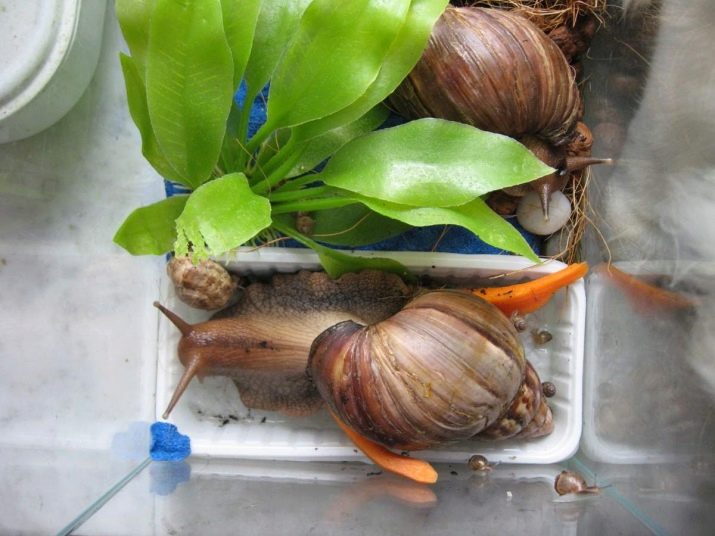
Arrangement of ulitaria implies the creation of the environment as safe as possible for land snails. In the tank, it is necessary to create ventilation openings with which the microclimate will be regulated.
The vents should not have too large a diameter, otherwise small snails through them will be able to get out.
A special substrate is laid on the bottom of the terrarium - peat, coconut or soil, with a layer thickness of 2 to 10 cm, scenery, plants, bowls and drinking bowls are immersed. A lid is placed and fixed on the surface of the container. House for snails, which are active mainly at night, additional lighting is not needed. For them, a regular change of day and night is much more important. Do not place them in parts of the room with bright artificial lighting.
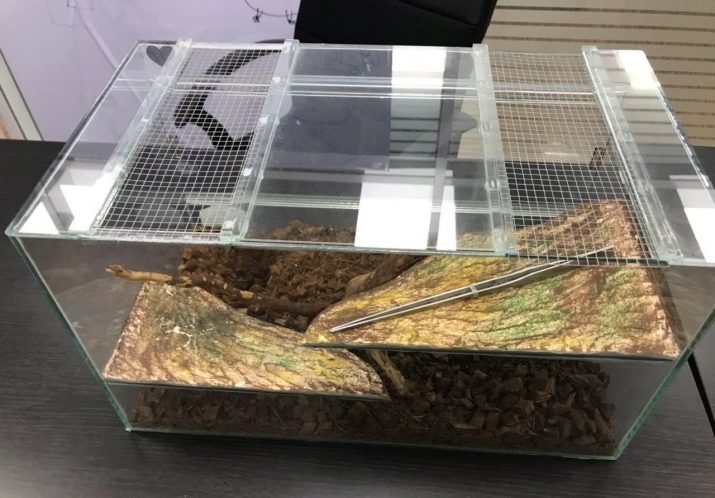
Temperature and humidity
The best living conditions for land snails imply the constant preservation of certain temperature and humidity indicators. Sharp changes in the state of the environment are especially dangerous for mollusks. The best are considered indicators of + 20-26 degrees Celsius. When these indicators decrease, tropical mollusks can hibernate.
The species that live in central Russia are able to withstand lower temperatures without any particular consequences.
Humidity is also important for snails living in captivity. The atmosphere inside the terrarium should have indicators of about 80%. Based on the type of mollusk, these parameters can vary by 10% in both directions. It is easiest to control this data with the help of special thermometers and hygrometers. Soil moisture should be optimal, because it is in this environment that the snails spend most of the day.

What and how to feed?
Snails are fed every other day or every day, depending on species and age. Young individuals are fed 2-3 times a day. Nutrition should be the most diverse and very moderate.
Periodically, it is worth changing products so as not to accustom the pet to too uniform a type of food.
The diet of domestic snails usually consists of:
Mineral fertilizing
They are needed for the intake of calcium in the body, the formation of the shell. Ground egg shells, chalk can act as top dressing, ready-made mixtures can be given.
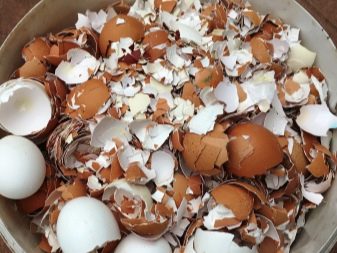

Fresh greens
It makes up the bulk of the diet, including lettuce leaves, young shoots of vegetables. It is useful to give your pets shoots of dandelions, plantain, sprouts of wheat and other cereals.

Fresh fruits and berries
Juicy pulp of raspberries, strawberries, melons, watermelon, pears and bananas is the best treat for the snail.

Vegetables
The pulp of pumpkin, zucchini, cucumber, tomato is suitable.

Protein products
Boiled egg white, meat, ready-made feed mixtures are given.

With a balanced diet, you can not worry about the health of the pet.
How to care?
The process of caring for snails at home will not seem complicated even for novice breeders.
Large pets of exotic species do not require special attention and spend most of the time in the ground.
But this does not mean that they will have to follow them less than the other inhabitants of the terrarium. Among the general rules:
- periodic bathing in warm water;
- full cleaning and cleaning of the aquarium at least 1 time per week;
- regular litter replacement;
- performing extraordinary cleaning if necessary.
Periodically, snails may hibernate.
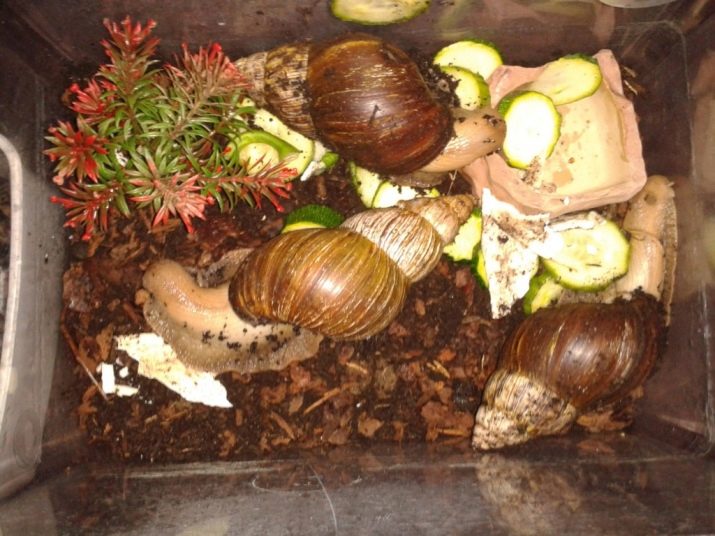
It is not recommended to extend this period by more than 2 months due to the high risk of mollusk death.
You can wake the snail by holding it for a while under a stream of warm water.
Sink care
A conch shell needs regular care and attention from a breeder.The larger the snail, the more attentive it will be to be the owner. If cracks, chips, other damages are detected, the volumes of mineral additives must be strengthened and the proportion of calcium in the diet increased. Similar measures are taken when detecting signs of molting, delamination of the shell. If there is a large crack or chip on the surface, the individual must be deposited separately, the risks of additional injury to be eliminated, and antiseptic treatment should be carried out.
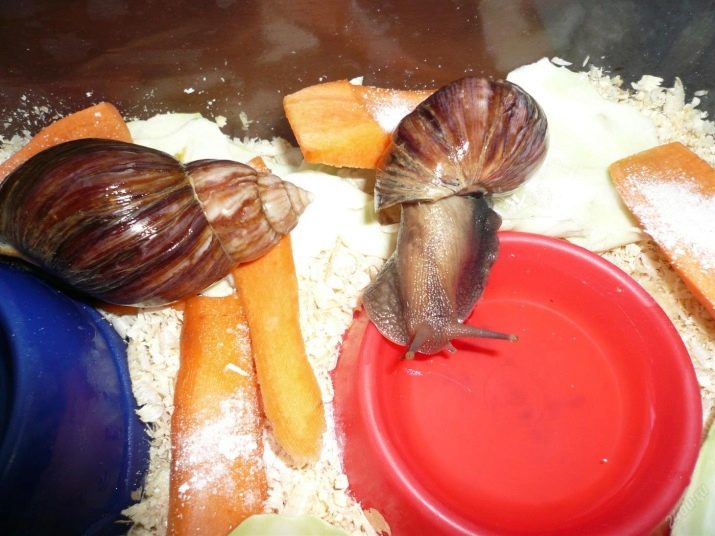
Bathing
Snails love to swim, but it is very important to do it right. To receive water procedures, the mollusk is planted in the palm of your hand and substituted under a thin stream of warm water.
Do not place the snail in a cold container with water, do not allow it to come into contact with household chemicals.
During a properly organized bathing, the pet will relax, show itself in all its glory.
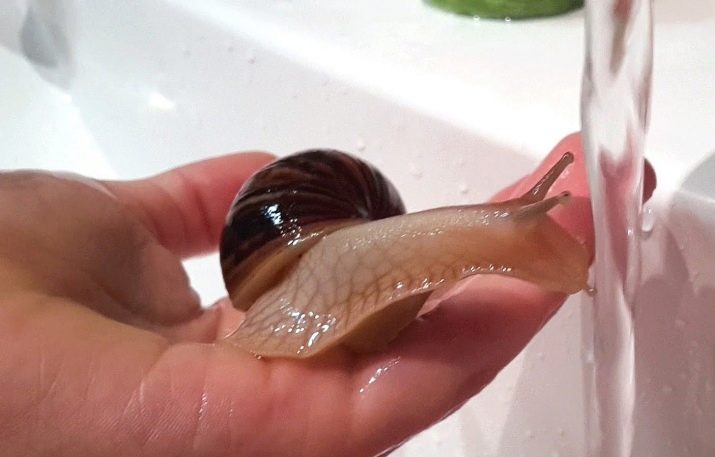
Disease prevention
If you violate safety measures or the rules for keeping a domestic snail, pets can get sick. Signs of poor health include stratification of the shell, refusal to eat, general mollusk lethargy, and excessive mucus production. For to exclude possible problems, it is necessary to protect the snail from the neighborhood with larger or more aggressive speciespoor ventilation, excessive pollution of the container. Snails also become ill with a sharp temperature drop, an aquarium too close, or excessive substrate dryness. It is worth eliminating the sources of possible discomfort, and then the pets will feel better.

Egg and small clam care
Many snails are viviparous species - their babies are born after the eggs ripen in the mother's body. But there are egg-laying species, and their offspring require increased attention to themselves. Achatines (with the exception of some species) are among these types of snails - one of the most popular among land mollusks.
After fertilization, the snail hatches eggs for a certain time - for Achatina this period is 6 weeks. After this period, the female digs a hole in the ground and makes a laying.
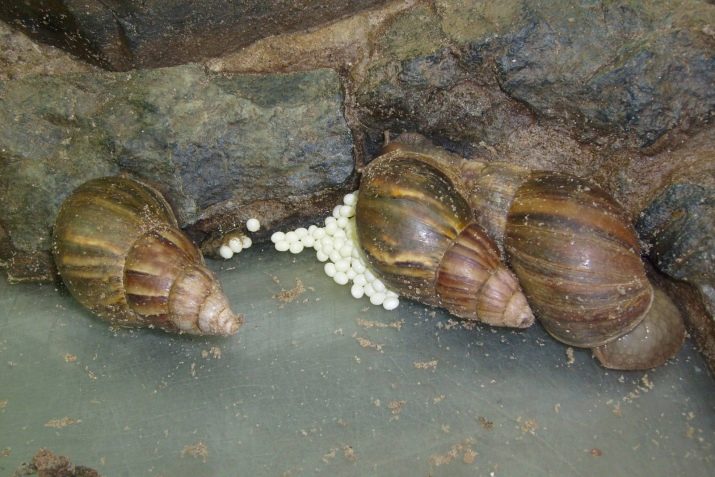
After this, it is not recommended to touch the eggs, except when they are scattered across the terrarium. If the masonry is made compact, when harvesting in the soil, it will be possible to notice round elements, similar to vitamins, with a fragile outer shell. False eggs are also found - without a strong shell, with a translucent, and not matte, color of the shell.
It is recommended to divide a very large masonry, freeze part of the embryos. You can not throw out the masonry without freezing, otherwise the snails can breed in the most unexpected places. Eggs are not recommended to be left without soil; they need high humidity and a constant temperature in the terrarium. It will be optimal to transfer the masonry to the "children's" aquarium - simply gently pry it with a spoon along with the substrate and transfer it, and then cover it with a moist litter.
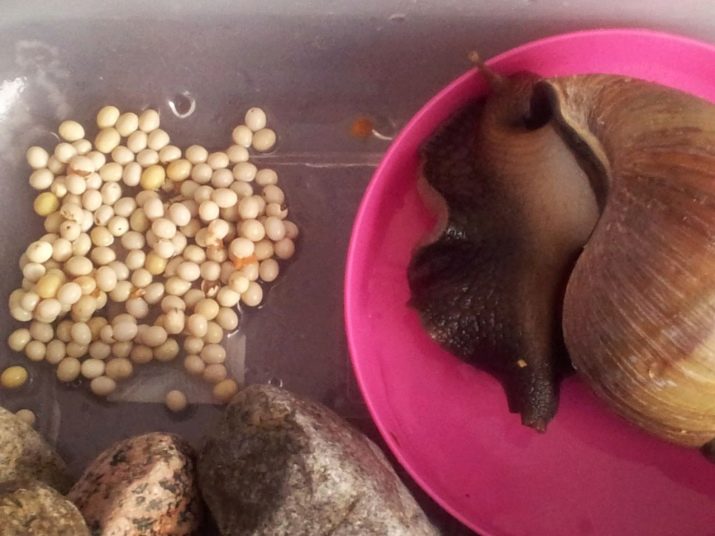
It will take about 1 month to wait for the appearance of the babies. Not all offspring will survive - you need to be prepared for this. If the babies are kept together with the mother, after their hatching, she will take care of the hatched children.
They crawl out of the soil after the shell of an egg is eaten.
Newborn snails require careful handling. Their shell is quite fragile, it can easily crack. Feeding should be done in a standard way, offering young animals the same food as adults, but with additional mineral additives to strengthen the shell.

Growing representatives of different species
Domestic snails are represented by a fairly wide variety of species, but this does not mean at all that any street mollusks are suitable for captivity. If you want to have a pet, you should give preference to the known and proven options. Almost all terrestrial species prefer to dig into the ground during the daytime, and come to the surface only at night. To properly contain them, you need to take into account their compatibility and some other important points.
Decorative domestic snails
Domestic snails need to be kept according to their species. Some species can be settled together, but their cohabitation will lead to interspecific crossbreeding.
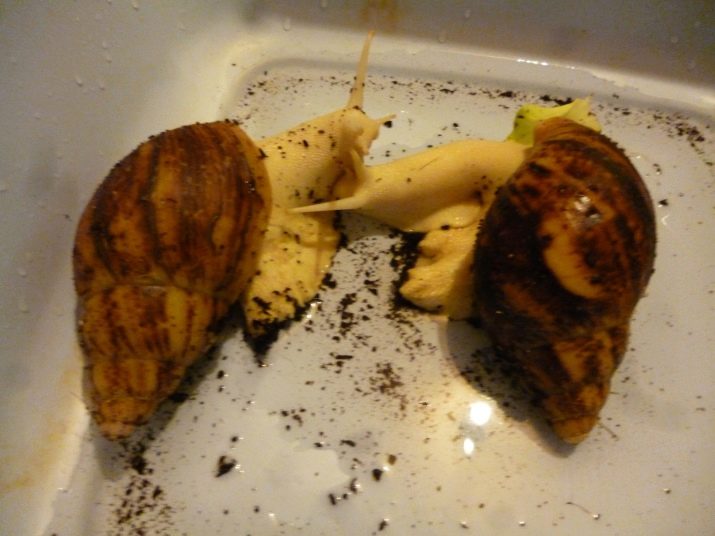
In addition, when large mollusks are combined with smaller ones, cannibalism attacks associated with a lack of nutrition can occur. Experienced breeders recommend not mixing the species in the terrarium and separate the compartment for the kids in the streetar so that they are not eaten by adult relatives.
Among the popular land and decorative mollusks for home maintenance, these species can be noted.
Achatina (reticulate, fulica, albino albopicta, immunoculate)
These African snails are exotic guests in Russian open spaces, but they are very popular and in demand due to their general unpretentiousness, contact and attractive appearance. Achatina are considered a species suitable for "training." They recognize the owner, are able to get used to a certain feeding schedule, like bathing, willingly communicate with the owner.

Grape
Small (up to 5-6 cm) snails that easily take root in terrariums. In content, they are as unpretentious as possible, have a diverse shell color.
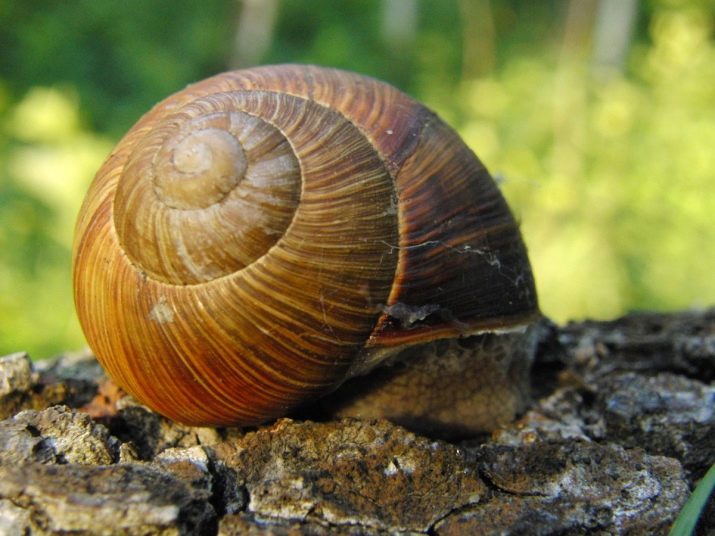
Garden
Ordinary earthen snails that cannot be bought at a pet store.
These street mollusks can be collected in the garden on a par with grape found in the southern regions of Russia.
A distinctive feature of garden snails is longevity - they are able to reach the age of 15 years, but on average they live only up to 7-8 years.
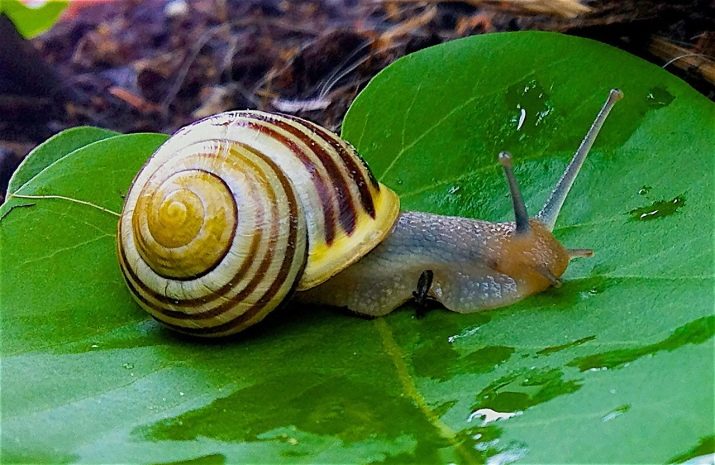
Archakhatins
Another African species of land snail, inferior to Achatina in decorativeness. The carapace of these snails has a rounded rather than pointed shape. The largest is a subspecies of marginate, it grows up to 16 cm in length.

Caracolus
Woody Cuban snails, the contents of which are recommended in a vertically oriented aquarium.
They are quite mobile, have sinks and saucers of bright colors.
It is better to start such pets in flocks, with the obligatory placement of branches and snags inside the terrarium.
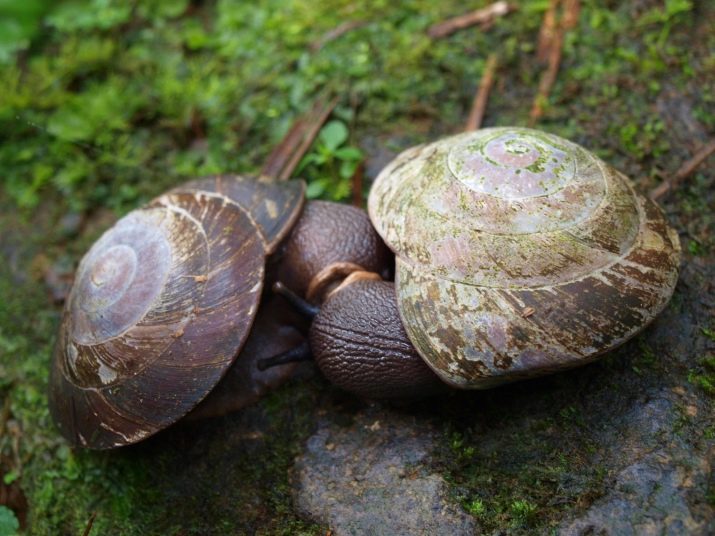
Octone Subbulins
Some of the smallest snails among domestic snails reach no more than 3-5 cm in length when kept in captivity. The colony is able to settle even in a miniature aquarium. Shellfish are unpretentious, and watching them is quite interesting. The only inconvenience may be uncontrolled breeding of snails.
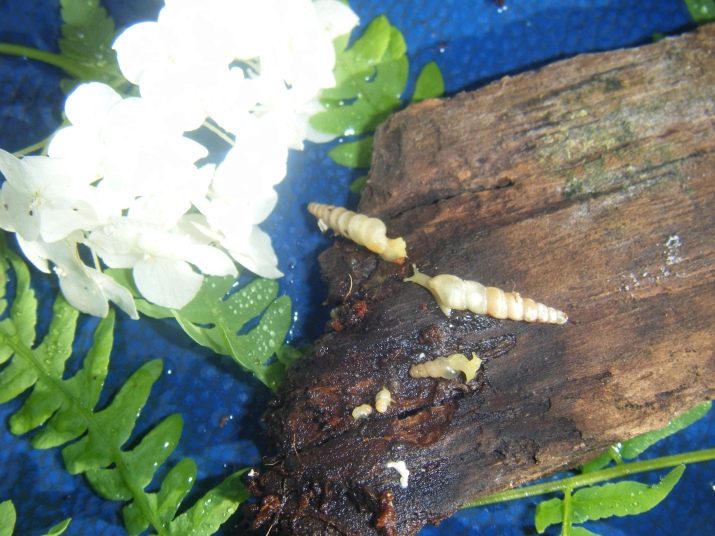
Megalobulimus or Megas
Land South American snails of gigantic size - shell length reaches 11 cm. Young snails are painted softly, in brown tones, have a large body in comparison with the shell. They are not too fertile in captivity, which compares favorably with Achatina, prefer to sleep for 2-3 days in the ground, it is not recommended to wake them up during this period.
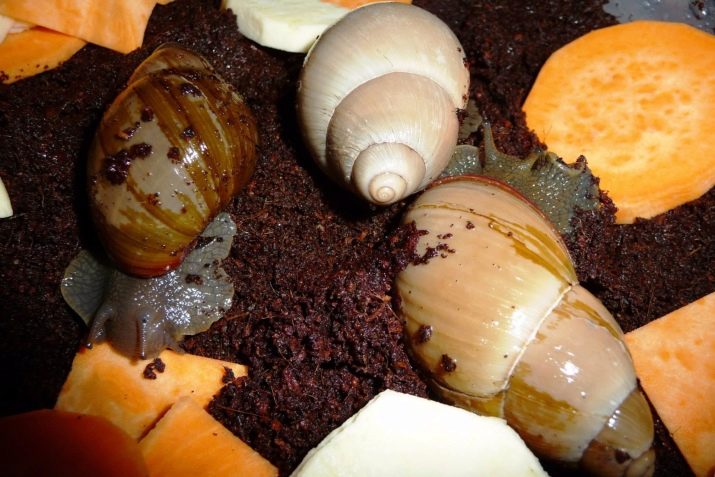
Recommendations for the care of land snails have practically no significant differences. They equip the litter with thick loose soil. In addition, the owner will have to:
- provide regular substitution of food trays;
- several times a week to carry out wet cleaning of the walls of the house;
- periodically perform a pet bath.
Freshwater mollusks suitable for domestic use - aquarium snails, can be acquired intentionally or accidentally get into the aquarium by transfer with plants or soil.
If you maintain a low abundance, soil species can provide loosening of the bottom substrate, soften water, fight against green algae and flowering water.
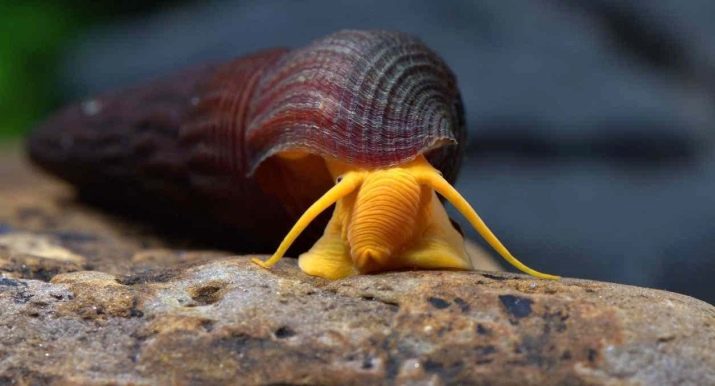
But with uncontrolled reproduction, the snails themselves can become a serious problem in the aquarium.
Among species suitable for aquarium maintenance, one can distinguish such.
Apulia
Large mollusk found in the USA in the natural environment. It stands out for its large size, it is quite popular among aquarists.
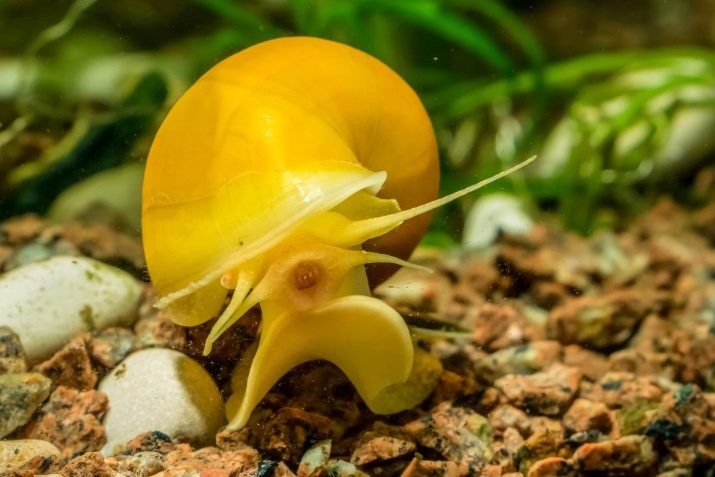
Batman
A snail capable of living in salt water. It is considered one of the best algae glass cleaners.
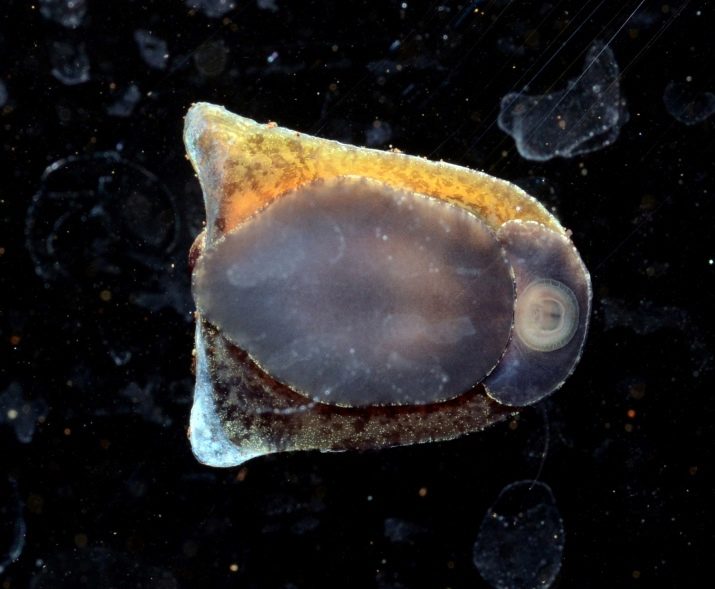
Helena
A predatory snail capable of providing natural control of the number of mollusks in an aquarium. It is wound up to destroy an overly proliferating population of smaller species.
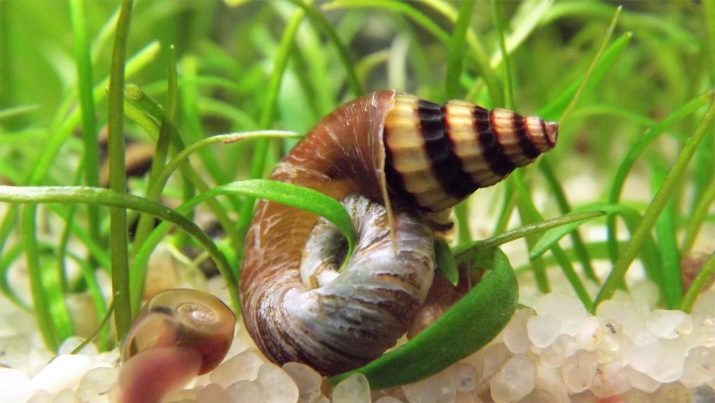
Horned freshwater
View of snails with a bright color of the shell, combining a black and yellow strip of horn-shaped growths on the shell.
In contact with mollusks, care must be taken - their horns are quite sharp, their injections are painful.
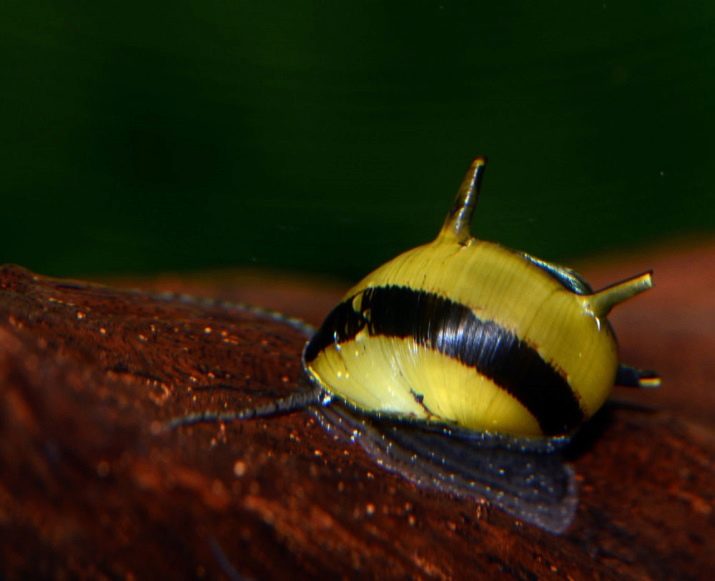
Marisa
Snail with a beautiful round shell. Marisa is peaceful, she can be settled together with different types of fish. But it is difficult for her to create optimal conditions of detention.

Devil's thorn
Snail with a luxurious conical shape sink. It requires salt water in the aquarium, the content is preferably in the aquarium without fish, but only with mollusks of the same species. Otherwise, the mollusk will sit in the ground most of the time.
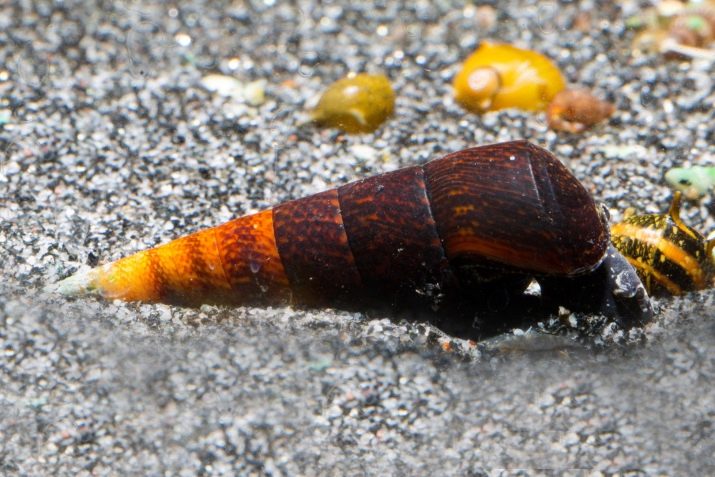
Tilomania or orange rabbit
Unusual mollusks native to Indonesia with a bright body color, the shade of which depends on the type of soil.
Especially popular are bright orange and yellow individuals. The more aggressive the environment, the richer the color.
Joint maintenance with fish and shrimp is not recommended due to the aggressiveness of the mollusk.
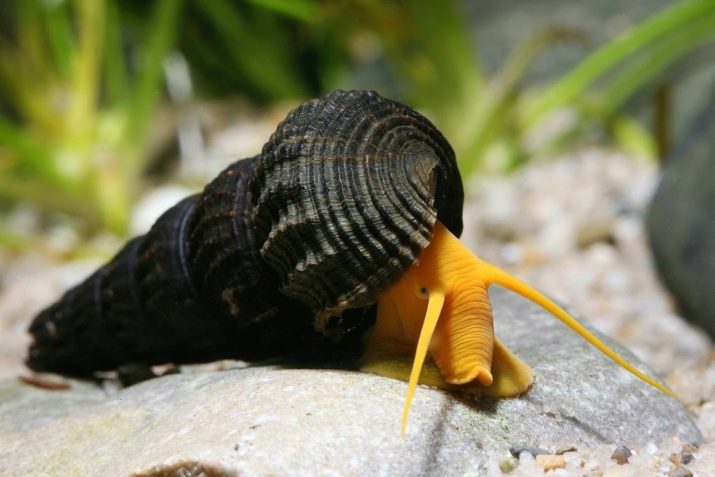
Neritina Zebra
A snail popular among aquarists, characterized by a livable character. In the aquatic environment, it acts as an orderly, destroying harmful green algae. The brightly colored striped shell has a black background and green-yellow stripes of different widths. The mollusk is sensitive to water quality, gets along well with calm aquarium fish, and needs additional feeding.
When kept together with the fish, snails do not need additional care - they are content with food debris, algae.
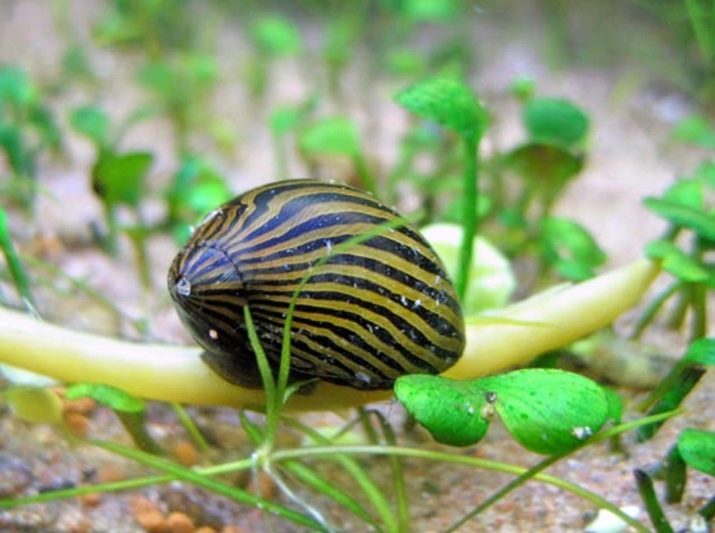
But with an increased number of snails, their conditions may worsen. The optimal population density is no more than 1-2 mollusks per 5 liters of water.
Observing the recommendations for care and maintenance, it is possible to create for both water and land snails optimal conditions for living at home. It is always worth considering the individual characteristics of the species, paying sufficient attention to the health of the pets. Then observing the mollusks will bring only positive emotions.
On how to keep snails at home, see below.
